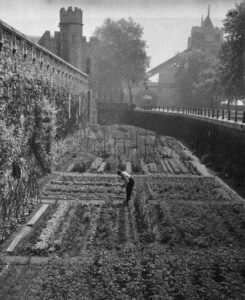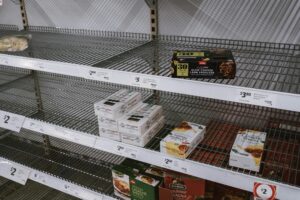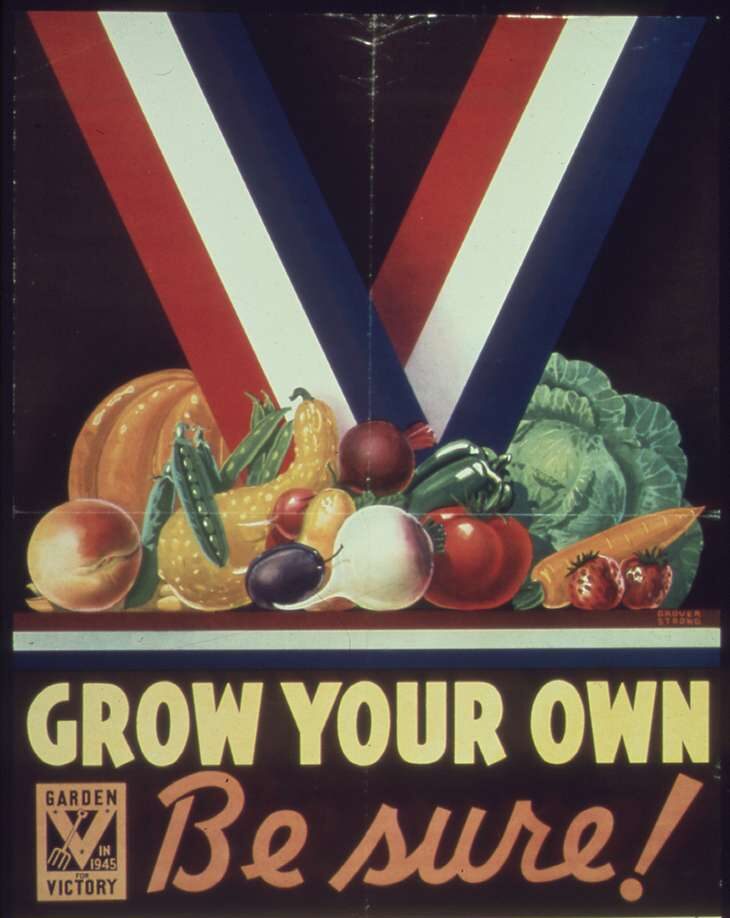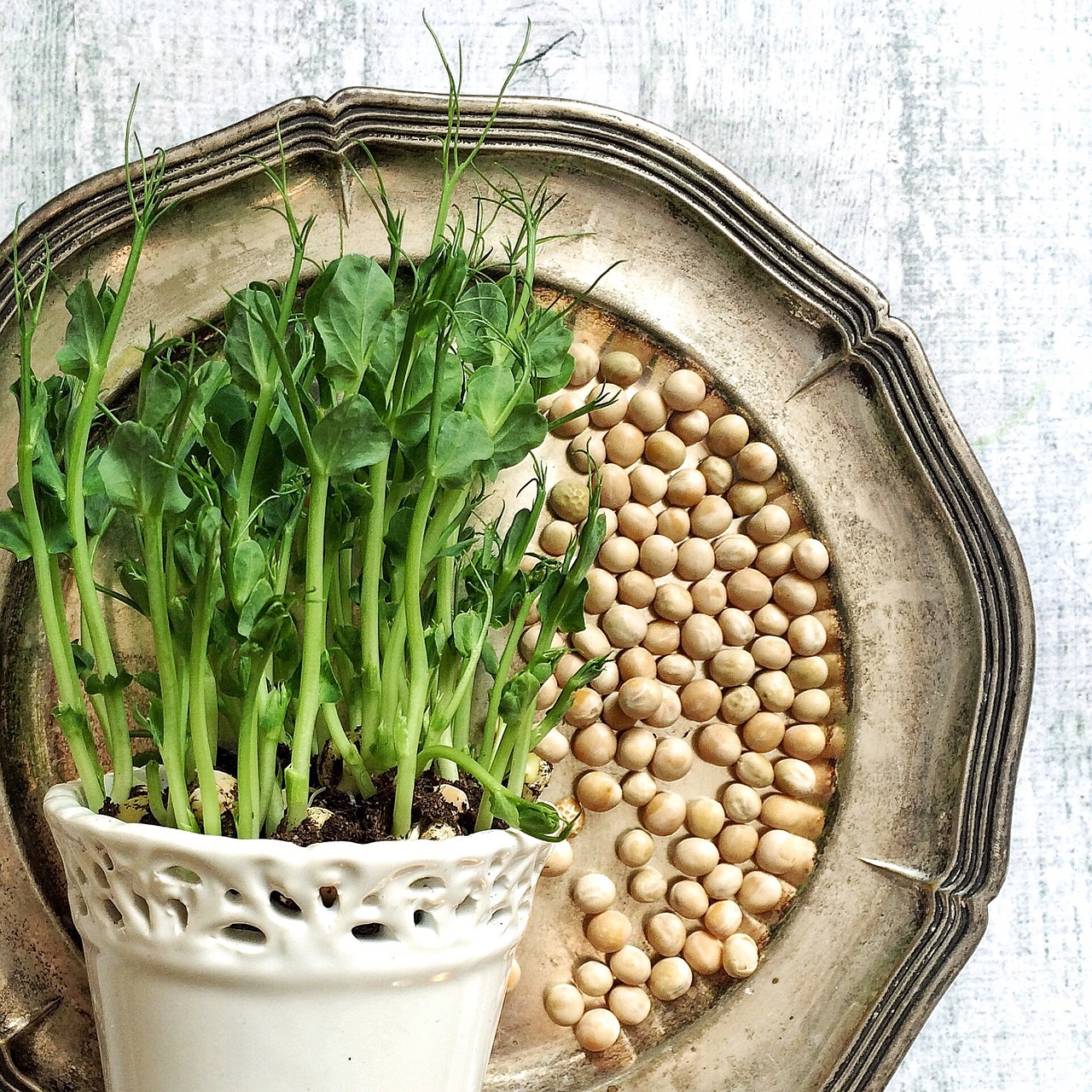There are plenty of videos and books that tell you how to grow edible plants, but most of those books assume you have a backyard and a roto-tiller. Most people do not have one or both of these things, so they assume that gardening is out of reach for them. But this series will introduce you to gardening in many non-traditional ways so that you can have your own Victory Garden regardless of circumstances.
What Is a Victory Garden?
The “Victory Garden” concept was created during WWII and was heavily used in England and the United States.
During the early part of the War, England was largely blockaded by German U-Boats (submarines), preventing a lot of food from the Continent and the Commonwealth nations (Australia, in particular) from reaching England. England was nowhere close to being able to feed itself from its own land at the time, so starvation was an imminent threat. The British government took control over all existing farms as a war industry and reduced the amount of livestock being kept, trading it for grains and vegetable crops. Poor pieces of land, which had been left fallow because they were not worth the effort, were pressed into service. Even road right-of-ways and other strips of marginal land, too small to farm, were used to grow fodder for the animals that did remain.
This is a great series on how farming in Britain worked during World War II:

But even maximizing farming was not enough to keep Britain fed. The government encouraged every British family to “Dig for Victory” and turn their front gardens and backyards into vegetable gardens. Public parks and marginal pieces of land around villages and cities were divvied up into allotments (or, as we would call them in the U.S., community gardens) and families who didn’t have garden space would use them to grow food. Even the dry moat around the Tower of London was pressed into service. No piece of usable land went to waste.
This is another great series on gardening and cooking under the rationing system in Britain:
America also had Victory Gardens, although the situation here was not so dire. America was (and still is) capable of producing all the food it needed to feed its people, and then some. The “and then some” was key, because America started sending food to England to try to keep it going. More than a little of that food ended up at the bottom of the Atlantic when the ships carrying it to England were sunk, but enough of it got through.
Not even counting the loss of food and materials due to enemy action, though, war is incredibly wasteful of resources. Men who could have been at home farming or producing goods in factories were, instead, consuming food and goods without producing in return. And after D-Day in 1944, as the Allied Forces began liberating Europe, food started to be shipped in from America to also help feed the people whose homes and farms had been destroyed. So America had the task of feeding itself, its own Army, and the people of England and Europe—all with a reduced workforce. This is why women went into the factories and kids and seniors at home gardened. Every bit of food grown by a family in their backyard was food that didn’t have to come from a farm—food that could be shipped to Europe or the Pacific to feed the troops and the starving civilians.
Why Do You Need a Victory Garden Now?
Western nations are in the middle of a Fourth Turning. Fourth Turnings are the destructive phase of the civilizational cycle that will lead to a new beginning. War, revolution, religious zealotry, and mass hysteria (like the 17th century’s witch trials and 18th century’s vampire panic) manifest during Fourth Turnings. To be more crude, people just lose their shit every 80-or-so years.
Some Fourth Turnings are worse than others, however. Our Fourth Turning is lining up with the destruction cycle of the American Empire. The average lifespan of an empire is about 250 years, so America is on its way out. The government can no longer lie about inflation: people can see with their own eyes that their food costs (among many other things) are going up much faster than their paychecks. In certain cities, retail theft is creating shortages of some goods (even of whole stores) and making people fearful of even going shopping. The supply chain never has fully recovered from Covid lockdowns, and government seizures of and “climate change” restrictions on farms, like in the Netherlands, or war in places like Ukraine, have only exacerbated the supply chain problem. Add in a fire here, a collapsed bridge there, a drought or outbreak of disease everywhere, and the next thing you know, you can’t get eggs, sugar, beef, coffee, or any number of other things.
Like the people of Britain in 1939, we are facing food insecurity—even though most people don’t realize it yet. And what makes a poor family in a hollowed out Rust Belt town food insecure may not be the same thing that makes a middle-class person in a crime-riddled city food insecure, but the end-result is the same.
 Growing your own food—even if it’s only a small portion of what you need to eat to live—helps smooth out the bumps in the road. Every step you take to make yourself independent of a failing system means one more bit of peace of mind. If there comes a day when you have nothing to eat except for some lettuce growing in your windowsill and a miniature tomato plant in a hanging basket, you’ll be extremely glad you took the time to cultivate that little bit of food, because that will mean the difference between going hungry and having a bit of food and nutrition in your belly so you can make it to another day.
Growing your own food—even if it’s only a small portion of what you need to eat to live—helps smooth out the bumps in the road. Every step you take to make yourself independent of a failing system means one more bit of peace of mind. If there comes a day when you have nothing to eat except for some lettuce growing in your windowsill and a miniature tomato plant in a hanging basket, you’ll be extremely glad you took the time to cultivate that little bit of food, because that will mean the difference between going hungry and having a bit of food and nutrition in your belly so you can make it to another day.
That will be your own personal victory.
Gardening Challenges
Choose which scenario best matches your situation and find out how you can overcome the challenge to raise your own food:
- When You Have No Outdoors: Gardening Indoors
- When You Have No Ground: Growing on Balconies, Decks, Patios, and Driveways
- When You Have No Space: Urban and Micro Gardens
- When You Have No Water: Desert Gardens
- When You Have No Flat Ground: Gardening on Slopes
- When You Have No Freedom: Hiding Your Garden and Livestock from Thieves, HOAs, and Government Regulations
- When You Have Nothing: Renegade Gardening and Foraging

